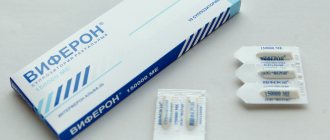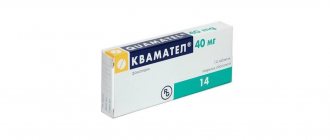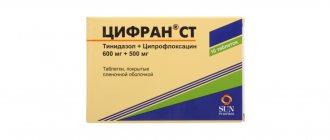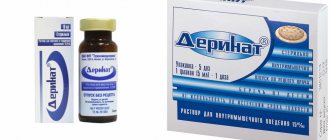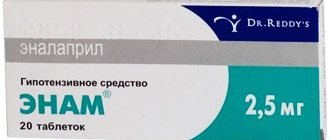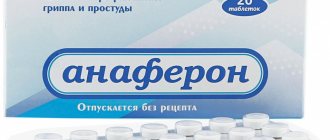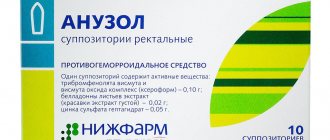Release forms of Nalgesin
The drug is available only in film-coated tablets. The main active substance is sodium naproxen. There are two types available in pharmacies:
- regular Nalgesin, one tablet of which contains 275 mg of active ingredient. The package contains 20 pieces;
- Nalgesin forte, one tablet of which contains 550 mg of naproxen. The box contains 10 or 20 pieces.
Auxiliary ingredients include povidone, microcrystalline cellulose, talc, magnesium stearate and purified water.
You can buy Nalgesin without a prescription at a regular pharmacy or through the website.
Interactions between Nalgesin and Nalgesin forte
The simultaneous use of naproxen with acetylsalicylic acid or other NSAIDs increases the risk of side effects, and with lithium it increases the concentration of the latter in the blood plasma; with diuretics - may reduce their diuretic effect; with cyclosporine - increase the nephrotoxicity of cyclosporine; with methotrexate - increase the toxicity of the latter; with antihypertensive drugs - reduces their effectiveness. It should be taken into account that when used simultaneously with anticoagulants, naproxen may increase bleeding time.
In what situations is Nalgesin taken?
The instructions for Nalgesin tablets indicate that use is advisable for:
- diseases of the musculoskeletal system: various arthritis, soft tissue rheumatism, bursitis, osteoarthritis of the spinal column and joints, tendovaginitis;
- mild or moderate pain - with neuralgia, myalgia, pain due to muscle strains and bruises, after surgical interventions in various areas, with headaches, migraines, toothache, adnexitis;
- heat and pain due to acute respiratory viral infections and diseases of infectious origin;
- alleviation of the condition and pain in infectious and inflammatory diseases of the ENT organs (otitis, pharyngitis, sore throat).
Special instructions for the use of the drug Nalgesin and Nalgesin forte
Patients with a history of upper gastrointestinal diseases should be under medical supervision during treatment. Naproxen should be prescribed with caution to patients with ulcerative colitis and Crohn's disease due to the possibility of relapse or exacerbation of the disease. Caution should also be exercised when prescribing naproxen to patients with severe renal and hepatic impairment, heart failure, patients with epilepsy, porphyria, hemostasis disorders, as well as patients who have taken anticoagulants or fibrinolytics. 1 tablet of Nalgesin contains 25 mg of sodium, which should be taken into account by patients on a diet with limited salt. During pregnancy, the drug is prescribed only if the expected therapeutic effect for the mother exceeds the potential risk to the fetus. Not prescribed during the last trimester of pregnancy and during breastfeeding.
Cautions for taking the drug
Nalgesin tablets are contraindicated for:
- hypersensitivity to the main substance;
- the presence of attacks of bronchial obstruction, runny nose or urticaria after taking aspirin or another non-steroidal anti-inflammatory drug in the past;
- erosions and ulcers in the stomach or duodenum;
- complaints of gastrointestinal or other bleeding;
- acute intestinal inflammation;
- being in a state after coronary artery bypass surgery;
- violation of the blood clotting process;
- liver diseases in the active phase, including obvious liver failure;
- severe renal dysfunction, negative dynamics of kidney disease;
- pregnancy and lactation.
For some diseases, Nalgesin can be prescribed according to the instructions for use, but with caution. Among them: diabetes mellitus, coronary heart disease, arterial pathologies.
Also, under the supervision of a physician, it can be used in old age, with long-term use of NSAIDs, with simultaneous therapy with warfarin, prednisolone or acetylsalicylic acid.
There are possible undesirable reactions that can occur from different organs and systems, mainly when taking high doses of the medication:
- disruptions in the functioning of the digestive system: attacks of nausea, diarrhea, abdominal pain, stool retention, vomiting blood;
- skin manifestations: itching, baldness, increased sweating;
- disruption of the central nervous system: difficulty falling asleep or drowsiness, muscle weakness, disorder of thought processes, dizziness, problems with concentration;
- disruption of the cardiovascular system: increased heart rate, swelling, shortness of breath;
- deterioration of visual function, presence of tinnitus;
- problems in the urogenital tract: blood in the urine, disruption of the menstrual cycle, kidney failure;
- disturbances in the functioning of the hematopoietic organs;
- feeling of thirst, increase/decrease in blood glucose;
- allergies in the form of skin rash, angioedema.
To reduce the likelihood of discomfort from the digestive system, you need to take tablets in the minimum effective dose and for a short course.
Instructions for use NALGESIN® (NALGESIN)
Side effects can be minimized by using the drug at the lowest effective dose for the shortest period of time necessary to relieve symptoms.
Patients with gastrointestinal diseases, especially ulcerative colitis or Crohn's disease (including a history) taking naproxen sodium should be closely monitored by their physician, because the disease may recur or worsen. Serious gastrointestinal adverse reactions can occur without any preexisting medical conditions. As with other NSAIDs, the cumulative incidence of serious adverse reactions, gastrointestinal bleeding or perforation, increases linearly with duration of treatment. Taking naproxen sodium in high doses will also likely increase the risk of adverse effects.
The anti-inflammatory and antipyretic effects of naproxen sodium should be taken into account in infectious diseases, as it may mask the signs of these diseases.
Since naproxen sodium and its metabolites are eliminated primarily by the kidneys via glomerular filtration, it should be used with great caution in patients with renal impairment. In patients with renal failure, CC should be determined and then monitored during treatment. If QC is less than 20 ml/min, the use of naproxen sodium is not recommended.
Caution should be exercised in patients with hepatic impairment. In chronic alcoholic liver disease, and possibly also in other forms of cirrhosis, the total plasma naproxen sodium concentration is reduced, while the plasma concentration of unbound naproxen sodium is increased. It is recommended to take the drug in the lowest effective doses.
Patients with epilepsy or porphyria taking naproxen sodium should be under close medical supervision.
The use of the drug in combination with NSAIDs, including selective COX-2 inhibitors, should be avoided.
Gastrointestinal effects
Adults
In older patients, the incidence of adverse reactions with NSAIDs is higher, especially the incidence of gastrointestinal bleeding and perforation, which can be fatal.
Gastrointestinal bleeding, ulceration, or perforation, which may be fatal, has been reported with all NSAIDs at any time during treatment, with or without warning symptoms or a previous history of serious GI reactions.
The risk of bleeding, ulceration or perforation of the gastrointestinal tract is higher with increasing doses of NSAIDs in patients with a history of ulcers, especially if it is complicated by bleeding or perforation and in the elderly. In such patients, treatment should begin with the lowest dose. For such patients, as well as for patients who require concomitant use of low-dose acetylsalicylic acid or other drugs that increase the risk of gastrointestinal events, combination therapy with gastroprotective agents (eg, misoprostol or proton pump inhibitors) should be considered.
Patients with a history of GI toxicity, especially the elderly, should report any unusual abdominal symptoms (especially GI bleeding), especially during the initial stages of treatment. Patients receiving concomitant medications that increase the risk of ulceration or bleeding, such as oral corticosteroids, anticoagulants (eg, warfarin), selective serotonin reuptake inhibitors, or antiplatelet agents (eg, acetylsalicylic acid), should use caution.
If gastrointestinal bleeding or ulceration occurs in patients taking Nalgesin®, treatment should be discontinued.
Patients with gastrointestinal diseases (ulcerative colitis, Crohn's disease) should be careful when taking NSAIDs, as their condition may worsen.
Effects on the heart and blood vessels
Patients with a history of arterial hypertension and/or heart failure should exercise caution (consult a doctor or pharmacist) as There have been reports of fluid retention or edema while taking NSAIDs.
Clinical studies and epidemiological data suggest that the use of some NSAIDs (especially in high doses and during long-term treatment) may cause a slight increase in the risk of arterial thrombosis (myocardial infarction or stroke). Although evidence suggests that the use of naproxen (1000 mg/day) may be associated with only a minor risk, it cannot be excluded. Data regarding the effects of low doses of naproxen sodium, for example 275 mg, are insufficient to judge the possible risk of thrombosis.
Effects on the skin and subcutaneous tissues
NSAIDs may very rarely be associated with serious skin side effects such as exfoliative dermatitis, Stevens-Johnson syndrome and toxic epidermal necrolysis, some of which can be fatal. Patients are likely to be at greatest risk for these reactions when starting therapy:
- reactions that occur in most cases during the first month of treatment. The drug should be discontinued at the first appearance of skin rash, damage to the mucous membranes or any other signs of hypersensitivity.
Other effects
Nalgesin® should be used only after a thorough assessment of the benefit-risk ratio:
- for acute congenital disorders (for example, intermittent porphyria);
- for systemic lupus erythematosus (SLE) and mixed connective tissue diseases.
Careful monitoring by a doctor is necessary:
- with renal failure;
- with liver failure;
- immediately after major surgery (naproxen sodium should be avoided for serious recent injuries or at least 48 hours before surgery);
- patients with chronic hay fever, nasal polyps or obstructive pulmonary disease, because there is an increased risk of allergic reactions. This may manifest itself as asthma attacks (called aspirin-induced asthma), angioedema or urticaria;
- patients with allergies to other NSAIDs. Nalgesin® may increase the risk of hypersensitivity reactions. Severe acute allergic reactions (eg, anaphylactic shock) are very rare. At the first sign of serious hypersensitivity reactions after taking the drug, treatment should be discontinued. If these symptoms appear, appropriate treatment should be started.
Naproxen, the active ingredient in Nalgesin®, may temporarily inhibit platelet function (platelet aggregation). Therefore, patients with bleeding disorders should be closely monitored.
Long-term use of Nalgesin® requires regular monitoring of liver and kidney function and blood tests.
Long-term use of NSAIDs may cause headaches that do not disappear with increasing dosage of the drug.
The habitual use of analgesics, a specific combination of various analgesic drugs in patients with impaired renal function leads to an increased risk of renal failure (analgesic nephropathy).
Taking NSAIDs simultaneously with alcohol increases side effects, especially from the gastrointestinal tract and central nervous system.
Information on excipients
1 tablet of Nalgesin® contains 1.09 mmol (25.097 mg) sodium, which should be taken into account in patients on a sodium-restricted diet.
Preclinical Safety Data
The results of toxicological studies showed relatively low toxicity of naproxen sodium:
- undesirable effects mainly arise from the gastrointestinal tract. After oral administration, the LD50 was about 0.5 g/kg body weight in rats and more than 1.0 g/kg body weight in mice, hamsters and dogs.
Toxicity studies have demonstrated that mice, rabbits, monkeys, and pigs tolerate repeated doses of naproxen sodium and that toxicity is more severe in rats, especially dogs. Adverse effects are more likely to occur in the gastrointestinal tract and kidneys, as is the case with repeated administration of other NSAIDs.
No effects on fertility or embryotoxic or teratogenic effects were observed. If naproxen sodium is administered late in gestation, pregnancy is prolonged and delivery is delayed. It has also been found that naproxen sodium may have adverse effects on the fetal cardiovascular system (premature closure of the ductus arteriosus, congestive heart failure, pulmonary hypertension).
No mutagenic or carcinogenic effects of naproxen sodium have been reported.
Effects in preclinical studies were observed only at exposures sufficiently above the maximum human exposure, indicating little relevance for clinical use.
Special precautions when disposing of used medicinal products or waste resulting from the use or handling of medicinal products
There are no special requirements for disposal. All remaining medicinal product and waste should be destroyed in an appropriate manner.
Impact on the ability to drive vehicles and operate machinery
Nalgesin® usually does not affect or has a minor effect on the ability to drive a car and operate machinery. When driving or operating machinery, the occurrence of certain side effects from the central nervous system (for example, fatigue and dizziness) should be taken into account. Driving a car or using other machinery may be difficult. These effects are aggravated when used simultaneously with alcohol.
In what dosages is Nalgesin prescribed?
The number of tablets, frequency of administration and duration of therapy depend on the indication for use and the amount of the main substance in one piece. The medicine is taken orally, washed down with sufficient quantity of water.
Nalgesin 275 mg is prescribed in the following regimens:
- to relieve pain, two to four tablets per day;
- for severe pain and in the absence of gastrointestinal diseases, with the consent of the doctor, the amount per day can be increased to six pieces, for a maximum of 14 days;
- as an antipyretic, take one tablet twice a day with a time interval of 6-8 hours;
- for gynecological pain, two tablets are first prescribed, then you need to switch to taking one tablet with an interval of 6-8 hours;
- for pathologies of rheumatic origin, initially take 2-4 tablets twice a day - in the morning and in the evening.
Nalgesin forte 550 mg is prescribed:
- for pain relief, one or two tablets per day;
- in case of severe pain, the amount can be increased to three tablets for up to 14 days;
- to reduce the temperature, first take one tablet, then switch to taking tablets with a dosage of 275 mg or half a tablet with a high dosage at intervals of 6-8 hours;
- for rheumatic pain, first take one or two tablets twice a day.
The classic daily dose is one or two tablets (or 550-1100 mg), which are taken in the morning and evening.
Pharmacological properties of the drug Nalgesin and Nalgesin forte
NSAIDs have analgesic, anti-inflammatory and antipyretic effects. The mechanism of action of the drug is due to inhibition of prostaglandin synthesis. After oral administration, it is quickly absorbed from the digestive tract. The maximum concentration in the blood plasma is reached 1–2 hours after administration and increases in proportion to the increase in the dose of the drug. About 99.5% of naproxen binds to plasma albumin at drug concentrations up to 50 mcg/ml. Approximately 70% of naproxen is excreted unchanged and approximately 30% is excreted as the inactive metabolite 6-dimethylnaproxen. Approximately 95% of the drug is excreted in the urine, about 5% in the feces. The half-life does not depend on the dose and plasma concentration and is 12–15 hours.
